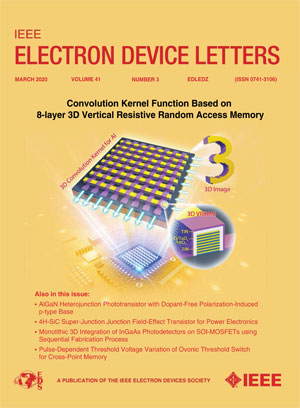Surround Gate Nanoscale Air-Channel Transistors via Ion Implantation Process for Amplification Applications
IF 4.1
2区 工程技术
Q2 ENGINEERING, ELECTRICAL & ELECTRONIC
引用次数: 0
Abstract
Nanoscale air-channel transistors (NACTs) are promising candidates for high-frequency, high-speed, and radiation-resistant applications. However, in existing three-terminal NACTs, the gate primarily controls the electric field near the source and within the air channel. This limitation hinders the achievement of saturation characteristics of the devices that restrict their applicability in amplifiers. It is also challenging for small gate voltages to effectively regulate output current. Additionally, the gate captures electrons emitted from the source, leading to significant gate leakage current issues. This letter introduces a novel surround gate NACT, employing IC-compatible fabrication techniques. The source is realized by N-type doping on a P-type silicon substrate using ion implantation process. This approach allows for effective control of electron concentration with small gate voltages, significantly altering both the emission electron number and the output current. The saturation output characteristics of the proposed NACTs are demonstrated experimentally, with the gate leakage current effectively reduced to the pA level. Additionally, an amplification circuit with a gain of 6.96 dB at 1 kHz and a cutoff frequency of 8.6 kHz is achieved. Our results provide a feasible method for the challenges of poor gate control capability and high gate leakage current of NACTs, demonstrating their significant potential in high-frequency amplification applications.求助全文
约1分钟内获得全文
求助全文
来源期刊

IEEE Electron Device Letters
工程技术-工程:电子与电气
CiteScore
8.20
自引率
10.20%
发文量
551
审稿时长
1.4 months
期刊介绍:
IEEE Electron Device Letters publishes original and significant contributions relating to the theory, modeling, design, performance and reliability of electron and ion integrated circuit devices and interconnects, involving insulators, metals, organic materials, micro-plasmas, semiconductors, quantum-effect structures, vacuum devices, and emerging materials with applications in bioelectronics, biomedical electronics, computation, communications, displays, microelectromechanics, imaging, micro-actuators, nanoelectronics, optoelectronics, photovoltaics, power ICs and micro-sensors.
 求助内容:
求助内容: 应助结果提醒方式:
应助结果提醒方式:


